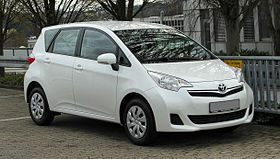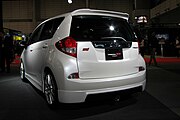Toyota Ractis
| Toyota Ractis | |
|---|---|
 2005–2007 Toyota Ractis (Japan) | |
| Overview | |
| Manufacturer | Toyota |
| Production | October 2005 – December 2017 |
| Body and chassis | |
| Class | Mini MPV |
| Body style | 5-door hatchback |
| Layout | |
| Platform | Toyota B platform |
| Chronology | |
| Predecessor | Toyota Yaris Verso/Fun Cargo |
| Successor | |
The Toyota Ractis (Japanese: トヨタ・ラクティス, Toyota Rakutisu) is a mini MPV produced by Japanese automaker Toyota. It is a five-seater mini MPV based on the Vitz and was introduced in October 2005 as the successor of the Yaris Verso/Fun Cargo. The name "Ractis" is derived from "Run", "Activity" and "Space".[1]
First generation (XP100; 2005–2010)
This section needs expansion. You can help by adding to it. (December 2018) |
| First generation (XP100) | |
|---|---|
 2007 Toyota Ractis (Japan) | |
| Overview | |
| Production | October 2005 – November 2010 |
| Assembly | Japan: Takaoka[2]; Iwate (Kanto Auto Works)[3] |
| Designer |
|
| Body and chassis | |
| Related | |
| Powertrain | |
| Engine | |
| Transmission | |
| Dimensions | |
| Wheelbase | 2,550 mm (100.4 in) |
| Length | 3,955 mm (155.7 in) |
| Width | 1,695 mm (66.7 in) |
| Height | 1,640–1,660 mm (64.6–65.4 in) |
| Curb weight | 1,120–1,210 kg (2,469–2,668 lb) |
The first generation Ractis was initially only sold in Japan and is available at Toyopet Store dealerships. Sales in Hong Kong started from October 2009.[4]
Second generation (XP120; 2010–2017)
| Second generation (XP120) | |
|---|---|
 Toyota Verso-S 1.3 Life (Germany) | |
| Overview | |
| Also called |
|
| Production |
|
| Assembly | Japan: Kanegasaki, Iwate (Kanto Auto Works)[5] |
| Body and chassis | |
| Related | Toyota Vitz (XP130) |
| Powertrain | |
| Engine | |
| Transmission |
|
| Dimensions | |
| Wheelbase | 2,550 mm (100.4 in) |
| Length | 3,995 mm (157.3 in) |
| Width | 1,695 mm (66.7 in) |
| Height | 1,585–1,705 mm (62.4–67.1 in) |
| Curb weight | 1,090–1,170 kg (2,403–2,579 lb) |
The second generation Ractis was unveiled at the 2010 Paris Motor Show as the Toyota Verso-S (Japanese: トヨタ・ヴァーソ・S, Toyota Vuāso S).[6][7] The Ractis is produced at the Iwate plant by Kanto Auto Works. It is available in 1.3 L and 1.5 L engines with G, X and S grades in Japan. The introduction of the Verso-S marked the re-entry of Toyota into the European B-MPV segment. When it hit the market, the Verso-S had the shortest overall length of any mini MPV in Europe.[8]
The Verso-S is available with a choice of two engines, a 1.3-liter petrol unit or a 1.4 liter D-4D turbodiesel unit, both mated to a 6-speed manual transmission. The petrol derivative is also offered with an optional, Multidrive S CVT, which features a 7-speed, sequential paddle shift mode. The petrol model delivers a combined fuel economy of 18.2 km/L (51 mpg‑imp; 43 mpg‑US) and CO2 emissions of 127 g/km. The diesel model delivers 23.25 km/L (66 mpg‑imp; 55 mpg‑US) and 113 g/km respectively.[9]
On June 30, 2016, Toyota confirmed that the Ractis reached the end of production for Japanese, Hong Kong and Macau markets, but the Verso-S continued to be produced for European markets until 2017. Sales of the Ractis in Japan ended on August 31, 2016. It was succeeded by the Toyota Tank/Roomy. The 5-seater variant of the facelifted XP170 Sienta, the Funbase, which was released on September 11, 2018, is also considered as the successor of the Ractis.
Subaru Trezia
Subaru announced a rebadged OEM version of the Ractis for the Japanese market on November 29, 2010. Known as the Subaru Trezia (Japanese: スバル・トレジア, Subaru Torejia), the badge engineered model receives unique bumpers, grille, bonnet, front fenders, headlights, rear finisher and taillight lenses. The name "Trezia" derives from the English language word "treasure".
Engines available consisted of a 1.3-liter 1NR-FE and 1.5-liter 1NZ-FE, coupled with a CVT. Front-wheel-drive is offered as the entry level layout for both engines, with all-wheel-drive available as an upgrade on the 1.5-liter version.
In January 2011, Subaru debuted an STI tuned "Trezia STI" at the Tokyo Auto Salon.
-
Toyota Verso-S 1.3 Life (Germany)
-
Subaru Trezia
-
Subaru Trezia STI
-
Subaru Trezia STI
References
- ^ ラクティスの車名の由来は何ですか? (in Japanese). toyota.jp. Retrieved 2011-03-19.
- ^ "History of KANTO AUTO WORKS". Kanto-aw.co.jp. Retrieved 2010-07-16.
- ^ "Kanto Auto Works, Ltd". Kanto-aw.co.jp. Retrieved 2010-07-16.
- ^ "豐田 Ractis 行貨正式引入香港,香港第一車網,Inside Logic Media Limited,2009-10-2" (in Chinese). Car1.hk. 2009-10-02. Retrieved 2010-10-22.
- ^ a b "Affiliates (Toyota wholly-owned subsidiaries)-Toyota Motor East Japan, Inc". Toyota Motor Corporation. 2012. Retrieved 2014-07-21.
- ^ "ラクティス". Toyota.jp. Retrieved 2011-09-04.
- ^ "Verso S". Toyota.
- ^ "Paris Preview: Toyota Verso-S gets an iQ-inspired makeover". Autoblog.com. 2010-08-31. Retrieved 2010-09-26.
- ^ "Paris Show: Toyota Targets Honda Jazz / Fit with New Verso-S MPV". Carscoop. 2010-09-30. Retrieved 2010-10-01.




